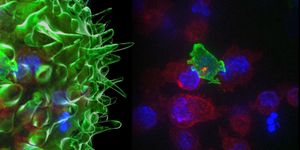A new report from Shinya Yamanaka, who won a Nobel Prize for his work on stem cells, has been
published in the Proceedings of the National Academy of Sciences. In the work, Yamanaka and colleagues have discovered a way to improve the efficiency of stem cell reprogramming.
The promise of stem cells met with many ethical challenges. Stem cells have the ability to become any type of cell in the body, but they are primarily in that state during the embryonic stage of development. But a breakthrough was achieved when Yamanaka figured out how to induce that non-specific, pluripotent state. However, the process is still very difficult. With the existing techniques, less than one percent of adult skin cells that are used to create induced pluripotent stem cells (iPSCs) are successfully reprogrammed. There is more information about iPSCs in the video above.
"Inefficiency in creating iPSCs is a major roadblock toward applying this technology to biomedicine," explained Yamanaka, a senior investigator at the Gladstone Institutes and director of the Center for iPSC Research and Application (CiRA) in Japan. "Our study identified a surprising way to increase the number of iPSCs that we can generate."
The investigators had originally aimed to make an experimental model for the study of a very rare genetic disease, fibrodysplasia ossificans progressiva (FOP). It causes ligaments, tendons, and muscles to turn into bone; as such it has the nickname "stone man syndrome." The disorder results from a mutation in the gene ACVR1, which causes the overactivation of a cellular signaling pathway involving the BMP protein and functioning in the development of the embryo.
The researchers were surprised to observe that creating iPSCs was easier when using cells taken from FOP patients compared to healthy individuals. The scientists suspected that it was because BMP can enhance cell replication, and helps them remain in a pluripotent state, one in which they can become any cell type. The hypothesis was tested through the manipulation of BMP signaling. Prevention of BMP signaling meant fewer iPSCs were made from the cells of FOP patients, while conversely, activation of the signaling pathway created more iPSCs.
"Originally, we wanted to establish a disease model for FOP that might help us understand how specific gene mutations affect bone formation," said first author of the report, Yohei Hayashi, PhD, a former postdoctoral scholar with Yamanaka. "We were surprised to learn that cells from patients with FOP reprogrammed much more efficiently than cells from healthy patients. We think this may be because the same pathway that causes bone cells to proliferate also helps stem cells to regenerate."
"This is is the first reported case showing that a naturally occurring genetic mutation improves the efficiency of iPSC generation," commented co-author Bruce Conklin, MD, a senior investigator at Gladstone. "Creating iPSCs from patient cells carrying genetic mutations is not only useful for disease modeling, but can also offer new insights into the reprogramming process."
A May 2016 interview with Shinya Yamanaka about his Nobel-winning work is shown in the video above.
Sources:
AAAS/Eurekalert! via
Gladstone Institutes,
PNAS








